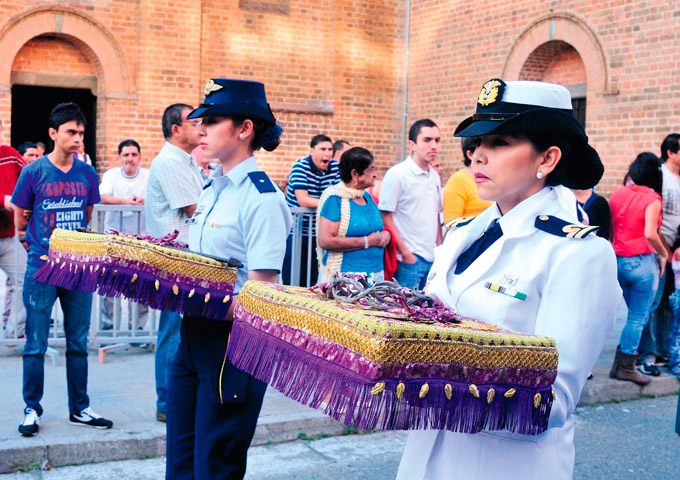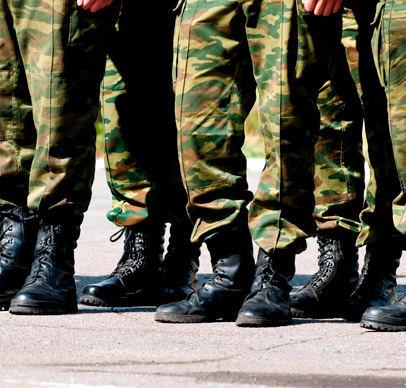Women in the military forces: between stereotypes and unresolved questions
By: Juliana Vergara Agámez
Photos:
Society and Culture

By: Juliana Vergara Agámez
Photos:
The most recent information available on women in the Colombian Military Forces indicates that 3,838 women were active in their ranks by the end of 2016. Further, 1,515 held officer and non-commissioned officer positions in the Army, 780 in the National Navy, and 1,038 in the Air Force, according to information from the Ministry of Defense. Meanwhile, at the same time, the number of men was 232,843. This is, approximately, a ratio of 60 men per woman.
Researchers María Catalina Monroy and Catalina Chacón from the Faculty of International, Political, and Urban Studies of Universidad del Rosario want to understand what drives women to begin a military career and the impact their presence has on decision-making within the military institution— an organization that, as the figures show, has a limited inclusion of the female gender to begin with.
The title of their research is Women’s Leadership in the Colombian Military Forces and is guided by two questions:¿What is known about women in leadership positions?¿ Is their leadership different from men’s; if so, why?¿ So explains Monroy, International Relations Program Coordinator and main researcher of the WomanStats Project in Latin America, an international research initiative concerning the n and security of women in 176 countries of the world (see chart).
Although the project is still in an exploratory phase, Chacón and Monroy are aware that they are entering a novel topic for Colombia and expect to contribute an unexplored perspective as no previous research has been done in this regard. During their research, the researchers faced an equally interesting fact: The country lacks a robust base of studies and research that delves into this subject, while descriptive articles, press, and other investigations abound, which unfortunately fall into the category of ‘commonplace’documents as Monroy points out. However, nonetheless, in the same process, the researchers found interesting studies albeit on an international level.
Among the most repeated generalizations that stand out include, for example, that women entering the Military Forces suffer from a loss of femininity, a subjective comment in the researchers’ view that also ultimately reinforces and replicates similar old stereotypes. Another topic that appears repeatedly is that the inclusion of women in military institutions is a notable achievement for them, namely, in entering a space that had remained closed to them until a few decades ago. However, the changes that their presence has subsequently generated have not been studied in depth.
Monroy and Chacón want to go deeper and find a new definition of the ‘glass ceiling’, that is, the invisible barriers that limit women’s promotional possibilities in an organization. The project also seeks to review what men and women are experiencing beyond the‘fashion’of incorporating women into the ranks into present governments and military institutions differently.
To achieve her purpose, Monroy began administering a 50-question survey between 2017 and 2018 to 204 officers from the Army, Air Force, and National Navy, including both men and women. In this same period, she interviewed a group of seven women from the Military Forces, who were advancing the promotional course from major to colonel. Now that the context has changed, the second phase of the surveys and personal interviews will be mediated by the changes produced in the first two years of Iván Duque’s Government (the current President of Colombia) and the progress in implementing the Peace Agreement.
What the researchers are looking for with the survey is to know and measure the magnitude of the different perceptions between officers, men and women, who are in control of decision-making. They have pending a list of 25 in-depth interviews and 200 surveys that had to be postponed because of the coronavirus health emergency as these are conducted personally to generate an environment of trust and maintain confidentiality.

The project also seeks to review the experiences of men and women beyond the ‘fashion’ of incorporating women into the ranks to present governments and military institutions differently
Contribution to an international perspective
For Chacón, a student of Political Science and Government in her last semester and a young researcher, part of the relevance of the investigation is that the perspective is broadening WomanStats for the analysis of women in situations of conflict as such women will see themselves as not only victims or perpetrators but also leaders within the Military Forces. According to her, this is an important point because a considerable number of studies exist focused on women linked to illegal armed groups, as part of the Colombian armed conflict, that have not considered the role of military women.
Therefore, the study targets female troop commanders who make decisions regarding sovereignty, independence, and national territory defense—a substantially different role from that of the military pioneers who entered as administrative staff in the mid-20th century. Currently, the role of women is more in line with what Article 217 of the Political Constitution of Colombia mandates: “The Military Forces’ primary purpose shall be the defense of sovereignty, independence, the integrity of the national territory, and constitutional order”.
However, the researchers are sure that the perception of that role will have an additional variable, given the coronavirus pandemic, as it serves as “a window of opportunity to highlight women, although ironically, and can highlight stereotypes of care with which women are usually associated,” says Monroy. That will be verified with the phase that is underway.
The WomanStats Project is an initiative, which has its headquarters in the United States, that was born at Brigham Young University, in 2001, with the main objective of evaluating the relationship between the security of women and the stability and performance of security across countries. In its concept, violence against women turned out to be an effective factor in predicting the external behavior and the level of development of a State.
In 2014, its stage in Spanish began; in 2017, with seed funding, WomanStats UR was created with its headquarters in Universidad del Rosario, which centralizes WomanStats’ research in Latin America with Catalina Chacón as the only encoder and two main researchers for the region, María Catalina Monroy and Juan Pablo Vallejo, an independent expert dedicated to topics related to environment and climate change.
The database is open to the public on the website http:// www.womanstats.org/. It is considerably useful for the work of academics, students, journalists, researchers, and decision-makers all over the world as it allows the contrast between official information and other sources, such as news records, to be seen.
It is the widest and most relevant database of the situation of women at a global level with more than 350 qualitative and quantitative variables to understand the status of women in the 176 countries that are being followed up on. These variables are divided into three types: Social practices, laws, and data, which are collected from reports and news.